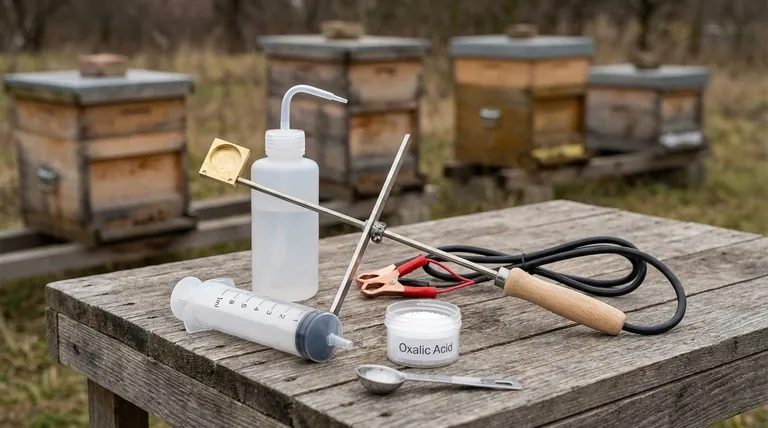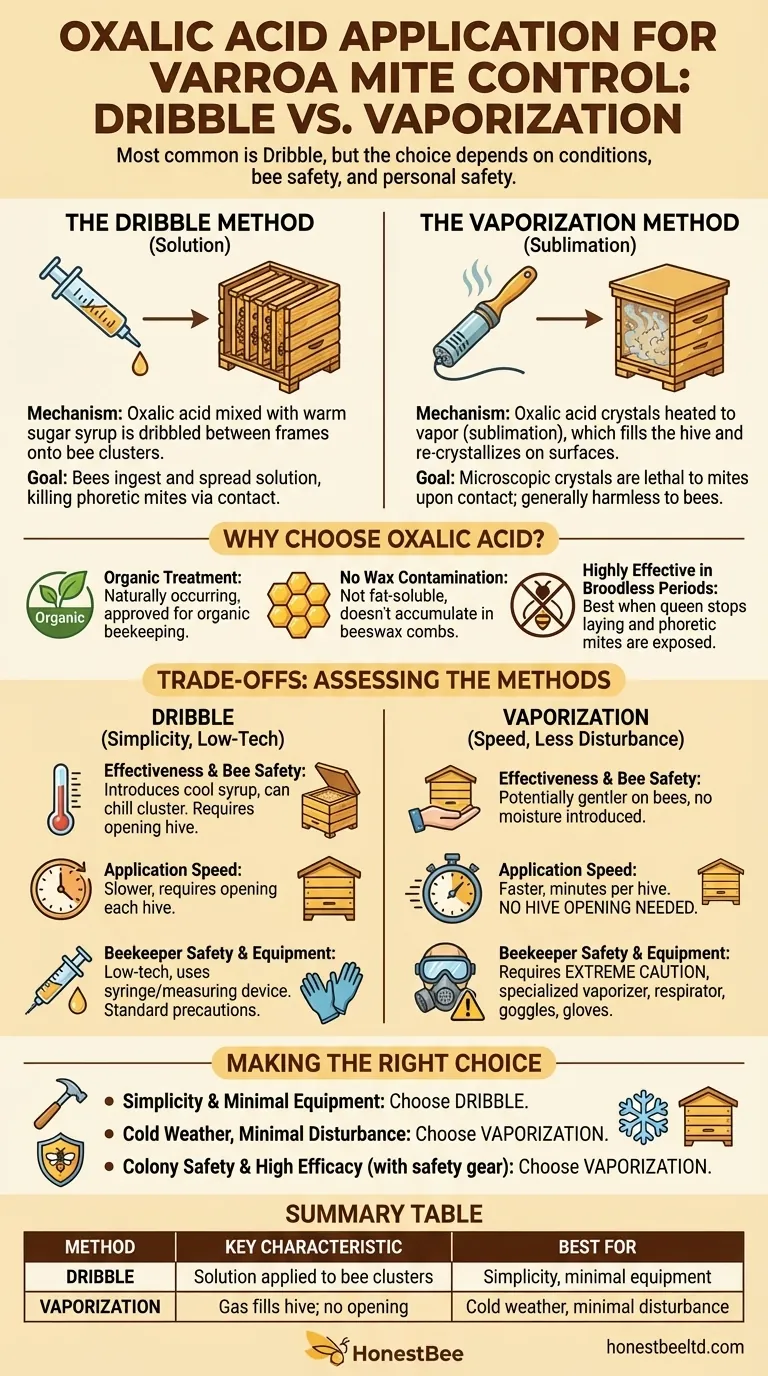While historically common, the most frequent method of applying oxalic acid for Varroa mite control is the dribble method. This technique involves mixing oxalic acid dihydrate with a warm sugar-water solution and applying it directly onto the bees between the frames of the hive, typically during a broodless period in late fall or early winter.
The choice between the two approved oxalic acid treatments—dribble and vaporization—is not about which is most common, but which is most appropriate for your specific conditions. Your decision will depend on weather, equipment, and your priorities regarding bee safety and personal safety.

Understanding the Two Approved Methods
Oxalic acid is a powerful tool against Varroa mites, but its effectiveness hinges on proper application. The two legally approved methods in many regions are the dribble and vaporization techniques, each with a distinct approach.
The Dribble Method
The dribble method involves creating a solution of oxalic acid and warm sugar syrup. This mixture is then carefully dribbled or trickled into the spaces between the frames, directly onto the bee clusters.
The goal is for the bees to ingest and spread the solution throughout the hive via contact, which kills the phoretic mites attached to their bodies.
The Vaporization (Sublimation) Method
Vaporization, or sublimation, uses a specialized tool to heat oxalic acid crystals. The solid crystals turn directly into a gas (sublimation) at approximately 157°C (315°F).
This vapor fills the entire hive cavity, eventually re-crystallizing into microscopic, sharp crystals on all surfaces, including the bees. These fine crystals are lethal to mites upon contact but do not harm the bees when applied correctly.
Why Choose Oxalic Acid?
Beekeepers turn to oxalic acid for several key reasons that make it a cornerstone of integrated pest management for Varroa mites.
It's an Organic Treatment
Oxalic acid is a naturally occurring organic compound found in many plants, including honey. When used according to guidelines, it is approved for use in organic beekeeping operations.
It Doesn't Contaminate Wax
Unlike some synthetic miticides, oxalic acid is not fat-soluble. This is a critical advantage, as it means the treatment does not accumulate in the beeswax combs of the hive, ensuring the purity of the wax and honey.
It's Highly Effective in Broodless Periods
Oxalic acid's primary function is to kill phoretic mites—the mites riding on adult bees. It cannot penetrate capped brood cells. Therefore, its efficacy is highest when the queen has stopped laying, typically in late fall or winter, and the mite population is fully exposed.
Understanding the Trade-offs: Dribble vs. Vaporization
Choosing the right method requires a clear-eyed assessment of the trade-offs between them, especially concerning bee health, beekeeper safety, and convenience.
Effectiveness and Bee Safety
The dribble method, while effective, introduces a cool syrup into the hive, which can chill the winter cluster. The references also suggest that vaporization is potentially less detrimental to bees and brood.
Vaporization treats the hive without introducing moisture and is considered by some to be gentler on the colony, especially in cold temperatures.
Application Speed and Convenience
Vaporization is generally a faster process, often taking only a few minutes per hive. A major advantage is that it does not require opening the hive, which is highly beneficial in late fall and winter as it prevents heat loss and minimizes disturbance to the colony.
The dribble method requires you to open the hive lid to apply the solution between each frame, which is more invasive and weather-dependent.
Beekeeper Safety and Equipment
This is a critical distinction. The dribble method is low-tech, requiring only a syringe or measuring device. However, vaporization requires extreme caution.
Heating oxalic acid creates fumes that are dangerous to the human respiratory system. A properly rated respirator, safety goggles, and gloves are non-negotiable personal protective equipment when vaporizing. It also requires the purchase of a specialized vaporizer.
Making the Right Choice for Your Goal
Your decision should be guided by your specific goals and conditions.
- If your primary focus is simplicity and minimal equipment: The dribble method is the more straightforward, lower-tech option.
- If your primary focus is treating hives in cold weather with minimal disturbance: The vaporization method is superior, as it is fast and does not require opening the hive.
- If your primary focus is colony safety and high efficacy: Vaporization is often preferred for being less disruptive to the bees, provided you use proper safety equipment for yourself.
By understanding these methods and their ideal timing, you can effectively protect your colonies from the damaging impact of Varroa mites.
Summary Table:
| Method | Key Characteristic | Best For |
|---|---|---|
| Dribble | Solution applied directly to bee clusters between frames. | Simplicity, minimal equipment investment. |
| Vaporization | Gas fills hive cavity; no need to open the hive. | Cold weather treatment, minimal bee disturbance. |
Protect Your Apiary with the Right Tools
Choosing the correct oxalic acid application method is crucial for effective Varroa mite control and the health of your colonies. HONESTBEE supplies commercial apiaries and beekeeping equipment distributors with the reliable supplies and equipment needed for both dribble and vaporization techniques.
We understand the challenges of large-scale mite management. Let us help you equip your operation for success.
Contact HONESTBEE today to discuss your wholesale needs and ensure your apiary is protected.
Visual Guide

Related Products
- Oxalic Acid Vaporizer 12V for Bee Varroa Mite Treatment
- Durable 12V Oxalic Acid Vaporizer for Varroa Mite Treatment Beehive Beekeeping Tool
- 12V Bee Mite Removal Evaporator Oxalic Acid Vaporizer for Bee Fumigation Treatment 180W Atomization
- Adjustable Formic and Acetic Acid Dispenser for Bee Mite Treatment
- Varroa Easy Check Mite Tester Kit Counter Alcohol Wash Jar
People Also Ask
- What should be done after applying the vapor? A Step-by-Step Guide to Sealing Your Hive
- What safety precautions should be taken when using oxalic acid for vaporization? Protect Yourself and Your Bees
- What safety precautions should be taken during Oxalic Acid Vaporization? Essential PPE & Procedures
- What are the registered application methods for oxalic acid in beekeeping? Choose the Right Varroa Mite Treatment
- How is the oxalic acid solution prepared for vaporization? No Solution Needed—Use Dry Crystals for Varroa Control













